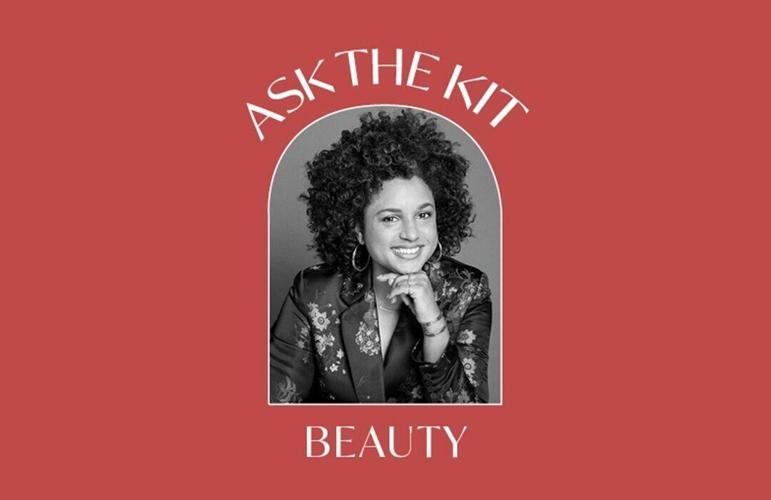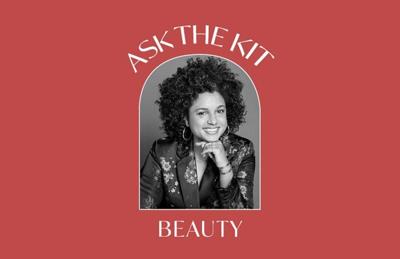Ask The Kit is the real-talk advice column you never knew you needed. Every month, writer Ingrie Williams answers your pressing beauty questions. How can I deal with frizz? Why is my skin freaking out? Send your Qs to ask@thekit.ca
âI find shopping for sunscreen so confusing. Mineral, chemical, broad spectrum ⊠Itâs like you need a chemistry degree just to understand what the bottles say. All I want is an SPF thatâs safe, effective and doesnât feel all gross and sticky. Help!â âAmanda, Belleville
Recently, my mother called me from the SPF aisle while shopping for a new sunscreen. âBut not a mineral one, theyâre too thick and chalky, right?â she asked, before I could name-drop anything helpful. As I steered her to one of my drugstore faves, which was indeed a mineral option, I was reminded that more awareness needs to be raised about the exciting new era of SPF weâre living in.
There are strong reasons why daily sunscreen is recommended for every skin type and tone. First, thereâs the skin health factor. When used properly, daily sunscreen can be a key skin cancer prevention tool. But, sadly, keeping melanoma at bay doesnât seem to be enough for most to reach for a tube every morning.
So, letâs examine the vanity angle. âMany people care deeply about the quality of their skin and wish to stay looking young and healthy. They invest in retinol, vitamin C serum, and moisturizers to anti-age,â says Dr. Danny Guo, a medical director, dermatologist and Mohs surgeon at Rejuvenation Calgary North. âWhile these are helpful, the single most effective anti-aging protocol is to use good quality sunscreen correctly and consistently.â
One without the other is just bad form. âIf youâre using other active ingredients in your skin care regimen, which I absolutely recommend, that means you have to be extra diligent with sun protection,â says Dr. Amanda Lau, medical director at Skinfolio in Vancouver. Thatâs because some actives can be photosensitizing, meaning they can make you more sensitive to the sun. Not only will SPF safeguard your complexion, it can actually improve its appearance. âMost of our clientele who have found a good sunscreen oftentimes find they donât need to use foundation.â The promise of a glowing complexion au naturel is something more of us can get on board with, no?
Even if you donât need to be convinced that daily sunscreen is a health essential with beauty-boosting benefits, you might need to hear that the SPFs of today have come a long way. True, we donât (yet) have shelf access to every elegant formula from overseas where things are on another level. But in recent years, formulators have been working hard to offer an array of skin-friendly textures that quash the traditional barriers to entry. Green-lit by Health Canada, there are now more options than ever that work for more people. Weâre talking blissful, light as air fluids alongside seriously hydrating creams that elevate radiance but donât feel greasy. Plus, thereâs a notable group of inclusive mineral formulas that have figured out how to disappear without a trace on dark and deep skin tones, and tinted options, too. Prices are accessible as well. You can splurge or save to your heartâs content. With this unprecedented abundance, Iâm confident that anyone can find âthe one.â
That said, more choice can make the selection process feel more overwhelming ⊠at first. But our experts have a few criteria that can help. Topping Lauâs list are two little words. âStart by looking for a sunscreen thatâs labelled âbroad spectrum,â which means itâs covering both UVA and UVB rays,â she says. UVB rays are responsible for burns, while UVAs contribute to dark spots, fine lines and wrinkles. âUVA causes aging deep down in the skin and weâre learning more and more about it,â Lau says. âEven when the sun is not shining and the sky looks overcast, there are still lots of UVA rays not visible to the eye. A broad spectrum formula will keep you protected from both.â
Next, zero in on the SPF, which stands for sun protection factor. The number indicates how long the sunâs rays would take to turn your skin red when using the product versus the amount of time without any sunscreen. For example, with SPF 30, it would take you 30 times longer to burn than if you werenât wearing sunscreen. But thatâs only true if youâre using the product as it was tested by Health Canada, which, no offence, isnât likely.
The Canadian Dermatology Association recommends a minimum SPF 30 for daily use, but both experts like to take it up a notch. âThe reasoning is simple: SPF value is measured in a lab with two milligrams for each square centimetre of skin. In order to achieve the labelled SPF value, patients also need to apply this amount of sunscreen,â says Guo. âUnfortunately, studies have shown that most people use only 25 to 50 per cent of the sunscreen needed to reach the labelled SPF value. Therefore, when using an SPF of 30, most people are probably only getting an SPF of anywhere between 7.5 and 15.â To overcome this issue, he always recommends using an SPF of 45 or higher all year round.
An easy application hack is the two-finger rule, which I use for sun protection in my morning routine. The pro-approved technique is pretty much what it sounds like: Simply pump or squeeze your SPF cream or lotion along your first and middle fingers, then massage the product onto your face. Iâll use another finger-length dollop to cover my neck, chest and ears.
Beyond daily application, Lau would also love to see more people becoming better at reapplying. âAlong with misconceptions about the SPF factor, when weâre seeing clients with burns and sun damage theyâll often report, âI put on sunscreen, but still got a burn,ââ she says. Reapplication every two hours is advised but should be done earlier if youâre getting your skin wet from swimming or sweating. âUse personal cues to remind yourself to reapply,â says Guo. âFor example, many of my patients are golfers. When playing 18 holes, I ask them to remember to reapply their sunscreen at the 10th hole. Itâs all about habit.â
With a broad spectrum formula and a solid SPF number in check, youâre all set to consider sunscreen filters. These are the active ingredients that reduce the impact of the sunâs rays. There are two types of filters available on the Canadian market â mineral and chemical â and they work in different ways to protect the skin. Mineral sunscreen, also referred to as physical sunscreen, uses zinc oxide and titanium dioxide to form a shield on the surface of the skin. âI have a strong preference for physical sunscreens, which not only absorb some of the rays but also deflect part of them,â says Lau. Mineral sunscreens are also the first choice of Guo. Theyâre more durable on the skin and a safe choice for pregnant people, young children and those with pigmentary conditions like melasma, he says.
Chemical sunscreens, on the other hand, are made with a wider array of ingredients, including homosalate and avobenzone. When applied to the skin, they work by absorbing UV light, which is then converted and released by the body. âMineral sunscreens are generally preferred over chemical sunscreens, but the difference is not significant for most people,â says Guo. âChemical sunscreens usually have better textures and are less likely to leave a white cast. In general, I recommend mineral only or mineral-and-chemical sunscreens.â
Your skin type can also inform your sunscreen selection, as being sensitive or acne-prone is another reason why a mineral sunscreen could be a better fit. âMineral formulas are a bit more inert, theyâre not acting and reacting, so they tend to be less stinging on the skin,â says Lau. Still, there isnât a one-size fits all answer. âSensitive skin is a big issue, but people have different sensitivities and what works for one individual doesnât always work for the other,â says Guo. âFor both sensitive and acne-prone skin, I always recommend medical grade cosmeceuticals as these will have the best evidence for safety in individuals with skin conditions.â
In my personal SPF lineup, I use a mix of mineral and chemical formulas along with a variety of product textures to protect from head to toe. For my oily-combination complexion, I seek out lightweight lotions or serum-like liquids for the face. A few long-standing faves include , and .
Whatever area youâre protecting, a liquid or cream sunscreen should always be used first to help achieve even and adequate coverage. From there, having a powder or stick on hand can set you up for easy reapplication. With spray sunscreens, itâs easy to miss a spot, and you can run the additional risk of triggering airway irritation if you have asthma, says Guo. He prefers powder sunscreen when reapplication with liquid is not practical. âEvery modality has its advantages in different situations,â says Lau, who keeps an SPF stick in her bag for easy, kid-friendly touch-ups when sheâs on soccer-mom duty.
Though it may take a bit of trial and error, the long-term payoff of finding a good SPF (for you) is worth every penny. âYou will absolutely be able to find one for your skin type that wonât break you out if youâre acne-prone and give you the most luminous glow,â says Lau. Treat your SPF like a part of your wardrobe and dress yourself every day. âA sunscreen is only good if it can get on your skin,â says Guo.
Shop the advice: A few of the best sunscreens on the market
The blurring SPF

Dermalogica Porescreen SPF 40
DermalogicaDermalogica Porescreen SPF 40, $77,
Niacinamide, prebiotics and green microalgae squalene meet up in this 100 per cent mineral sunscreen that delivers primer-like results.
The stick SPF

Aveeno Protect + Soothe Mineral Sunscreen Stick SPF 50
AveenoAveeno Protect + Soothe Mineral Sunscreen Stick SPF 50, $23,
Made for sensitive skin and ideal for sun protection on the go, this zinc oxide and pure oat essence formula glides on fuss-free.
The extra-luminous SPF

Sun Bum Original Glow 30 Moisturizing Sunscreen Face Lotion SPF 30
Sun BumSun Bum Original Glow 30 Moisturizing Sunscreen Face Lotion SPF 30, $23,
This tinted chemical formula imparts instant radiance and is loaded with antioxidant-rich kakadu plum.
The luxe SPF cream

Clé de Peau Beauté Protective UV Cream SPF 50+
ClĂ© de Peau BeautĂ©Clé de Peau Beauté Protective UV Cream SPF 50+, $168,
Ultra-creamy sun care blended with a botanical complex that moisturizes as it protects.
The mineral-chemical SPF

Vivier Sheer SPF 45
VivierVivier Sheer SPF 45, $76,
A hybrid of sunscreen filters plus vitamin E leads to weightless UV protection and a matte finish.
The brightening SPF

Shiseido Urban Environment Vita-Clear Sunscreen SPF 42
ShiseidoShiseido Urban Environment Vita-Clear Sunscreen SPF 42, $48,
Leaving a dewy glow, this lightweight lotion is infused with vitamin C to improve brightness and target dark spots day after day.
The powder SPF

Alyria Screen Out Loud Powder Sunscreen SPF 50
AlyriaAlyria Screen Out Loud Powder Sunscreen SPF 50, $39,
Available in two shades, this blend of mineral ingredients makes over-makeup touch-ups a piece of cake.
When you make a purchase through the links in this article, we may earn a small commission. Our journalism is independent and not influenced by advertising. Learn more.





































To join the conversation set a first and last name in your user profile.
Sign in or register for free to join the Conversation